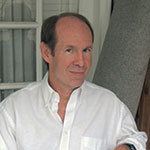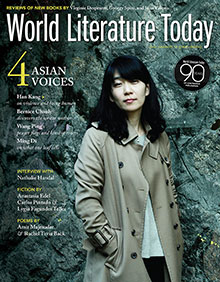The Neustadt Prize and the Framing Effect

Tesla owns the expertise on electric cars, Picasso on cubism, and the Neustadt Prize on casting a large net to evaluate international literature in unbiased fashion. And in so doing, the Neustadt Prize has reframed the field for everyone else.
It seems apt that the homeland of the creator of the Neustadt Prize was Estonia. It was there that a young Ivar Ivask, poet and scholar, negotiated the linguistic tsunamis of Swedish, Polish, German, and Russian that accompanied invasions. The nation was, said Marek Tamm, “born out of translation” (Diplomaatia, March 2010). Despite all those colonizers, Ivask noted, the Estonian language survived, one of the oldest in the world. “One day all of us will be translated,” he wrote in a poem; “yes even from the Estonian // the most difficult verse forms // will not deter eager Americans // looking for something new.” If that note about “eager Americans” seems prescient, Ivask was by then teaching at the University of Oklahoma. He had finished a PhD at the University of Marburg (in art history and comparative literature), immigrated to the US, and already taught at St. Olaf’s College.
In his new job, Ivask became editor of Books Abroad, founded by Roy Temple House in 1927. To look at the first 1927 issue today is to be struck by House’s purity of intent and the prescience of his choices. There were seventy-four reviews of literature in French, German, Spanish, and Italian. Publishing four times a year, the journal grew from 32 pages to 250 pages per issue by 1976. In that year Ivask wrote the half-century commemorative essay and laid out major changes.
Books Abroad had become World Literature Today, he noted, and the prize he had created in 1969 as the “Books Abroad International Prize” was going to be known as the “Neustadt International Prize for Literature.” The Neustadt family of Ardmore, Oklahoma, longtime benefactors of the university, had endowed the award in perpetuity. I like to think that in that moment Ivask, who had grown up looking into the calm, enduring forests of an Estonia “reframed” by other languages, seized the moment to reframe the very act of prize-giving.
The Neustadt Prize
As WLT executive director Robert Con Davis-Undiano has said, Walter Neustadt Jr. himself was marked by “a very special kind of innocence” that made it possible to set up the prize with a purity of intent. In a field already populated by nation- and language-specific literary prizes, the Neustadt Prize would take a higher road. Every two years it would recognize a living author, writing in any language (as long as a “representative portion” of work was available in English), for that author’s lifetime achievement. The jury would be composed of the executive director of WLT and a changing cast of international authors. This gave a kind of loose framework to the process that was augmented by a large number of nominees, who would range from nine to eleven.
The first class (1970) included Conrad Aiken, John Berryman, and Graham Greene but also Jorge Guillén, Pablo Neruda, and Alexsandr Solzhenitsyn (who never won). The eventual recipient was Giuseppe Ungaretti, a choice that in retrospect has a prescient, edgy quality. That note of knowing “what will have happened” twenty years in the future was to become one of the Neustadt’s distinctions, its cultural capital. Women broke into the nominees’ circle comparatively early, with Nathalie Sarraute in 1972, a year that also introduced non-Romance languages with Finnish, Polish, and Serbian nominees (Paavo Haavikko, Zbigniew Herbert, Czesław Miłosz [an eventual winner], and Vasko Popa). Auspiciously, however, it was Gabriel García Márquez who won the Neustadt that year, ten years before he won the Nobel in 1982.
That note of knowing “what will have happened” twenty years in the future was to become one of the Neustadt’s distinctions, its cultural capital.
It was the 1974 class that, in my view, solidified the Neustadt. Not only were there two women nominees (Doris Lessing and Anna Seghers of East Germany) but also Wole Soyinka from Nigeria, Eyvind Johnson from Sweden, Zaharia Stancu from Romania, and Georges Schehadé of Lebanon. That catholicity said to a casual observer that someone must be doing an awful lot of very dedicated reading. Such an observer would also note that nominees Henri Michaux of Belgium and Francis Ponge of France (the winner) represented an approaching wave of minimalist experimentation in French writing. Paul Auster did not consolidate this development in his Random House Book of Twentieth-Century French Poetry until a decade later. This early on, the Neustadt gained a reputation for recognizing brooks that might turn into rivers.
Not to overburden the reader with names, let me simply mention a few Neustadt laureates in support of my view: Elizabeth Bishop in 1976, Czesław Miłosz in 1978, Octavio Paz in 1982, Tomas Tranströmer in 1990, David Malouf in 2000, and Adam Zagajewski in 2004. Note those dates—usually well before the more popular applause. The list of nominees has been imaginatively broad, and it makes me wish that I had been in the room when the following writers were discussed: Anaïs Nin (1976), Günter Grass (1980), Ba Jin (1982, the first Chinese nominee), Mohammad Dib (1984), Kenzaburō Ōe (1986, the first Japanese nominee), Hélène Cixous (2006) and . . . Bob Dylan (2012).

The Problem with Prizes
We all know that there is a problem with literary prizes. They have grown immensely in number since the Nobel was established in 1901. Within a few years there were the Prix Goncourt (1903, for literature in French), the Pulitzer (1918, for American fiction), and the James Tait Black Memorial Prize (1919, literature in English published in Great Britain). As the language/nationality dispersion suggests, the prizes soon sought position on the field of opportunity, like the actors described by Pierre Bourdieu (Distinction , 1979) and Randall Collins (The Sociology of Philosophies, 1998). “Imagine a large number of people spread out across an open plain,” Collins writes, “something like a landscape by Salvador Dalí or Giorgio de Chirico. Each one is shouting ‘Listen to me!’ This is the intellectual attention space. Why would anyone listen to anyone else? What strategy will get the most listeners?”
One obvious tactic is to somehow distinguish oneself, to articulate what none have ventured, and we know that this often works in literature and in prizes also. Language, nationality, or topic may gain attention and attract a crowd. “There are first-mover advantages and bandwagon effects,” writes Collins: “The tribe of attention seekers, once scattered across the plain, is changed into a few knots of argument. The law of small numbers says that the number of these successful knots is always about three to six” (emphasis added). And here we must ask: How does an international literary prize domiciled in Oklahoma distinguish itself?
There are now over one thousand literary prizes, and several hundred in the US. There are ten prizes for baseball writing alone. The field is global, and we live in an age of prize fatigue. As I detail in Gatekeepers: The Emergence of World Literature and the 1960s (Oxford University Press, 2016), many of these prizes are nakedly commercial. In Japan the publisher Kodansha runs the Gunzo Prize through its Gunzo magazine in a bald attempt to discover new talent and cinch it in the harness. That’s where Haruki Murakami (Neustadt nominee in 2008, 2010, and 2014) got his first break, and as he ironically told an interviewer for Publishers Weekly in 1991, “You have to know there are many prizes in Japan.”
One way of looking at the prize proliferation is through the lens of James English in The Economy of Prestige (2005). His dissections of “taste management” and of “strategies of condescension” are trenchant, and his send-up of the Academy Awards is hilarious. But two of his chapters bear rereading, not least because they seem counterintuitive. To the question Is the prize field becoming overcrowded? English responds, “Not really.” That is because “each new prize that fills a gap or void in the system of awards defines at the same time a lack that will justify and indeed produce another prize.” While this defies Collins’s “Rule of Low Numbers,” English goes on to suggest that the onus “falls only on the most firmly established.” He argues that their early claims of “purity” or “integrity” cannot be long defended, especially as new prize promoters distinguish themselves initially by pointing to supposed conflicts in the records of their elders: “What we are looking at, even today, is a system ripe for further expansion,” English concludes. In a moment I will argue that the Neustadt is the case that proves him wrong, that its position of first mover and its “remoteness” preserve it.
French Connections
But first let me acknowledge that English is certainly right about the rest of the field. Its expansion predisposes it to commercialism, something that English blames on the French. The “Goncourt Academy” slid into a too-easy alliance with “France’s major publishing houses, Gallimard, Grasset, and Seuil,” and even the prize established to overturn that trend, the Renaudot, “has come to be associated with the ‘Galligrasseuil’ hegemony.” It is for these reasons, as well as the more obvious ones, that we will never see Houellebecq in Stockholm. It was not just the proliferation of book prizes in France that spurred their introduction to Great Britain, writes English, but also their commercial success. The Booker Prize created by Tom Maschler in 1969 is “explicitly modeled on the Goncourt.”
Later in his study, English argues that a rivalry between the French Academy and the Swedish Academy disrupted the path of the first Nobel Prize given to an African writer. It was long supposed that it would go to Léopold Sédar Senghor of Senegal, but in a dispute over authenticité the Senghor candidacy was derailed in favor of Soyinka, “the most prominent African writer of the backlash against Negritude,” who had once called wholly African literature “neo-Tarzanism.” Now, Soyinka had also been nominated for a Neustadt, but English connects his Nobel moment (1986) to a rhetoric of “honoring writers of world literature who could nonetheless and simultaneously be identified with local roots.” It’s that moment, he writes, when the commercialization of “world literature” arrived in bookstores, with Soyinka one of the first three non-Western authors in 1984 editions.
It’s not just the French prize system that has proven problematic; there is also the matter of translations. Gabriel García Márquez refused a French prize for the best foreign title because he didn’t like the translation (and suspected the rush to commercialize his work). And the clubbiness: the recent death of Edmonde Charles-Roux reminds us that she won the Prix Goncourt in 1966 for a roman à clef about being fired from the French Vogue published only months after she was fired. She went on to become a member of the Académie (1986–2016) and its president (2002–14). It seems preternatural that Bernard Pivot, himself recently fired from Apostrophes, was her successor. Below I will term all of these demerits the commercial frame.
The Framing Effect
As prize-giving grew over time, its decisions began to be “framed.” This “framing effect” is a kind of cognitive bias, examined notably by Daniel Kahneman (Thinking, Fast and Slow, 2011), in which people react to choices in different ways depending on how they are presented, as losses or as gains. People tend to avoid risk when a positive frame is presented but to seek risks when a negative frame is presented. Prize committees, being composed of people, act according to frames. But in literary awards they sense, even if unconsciously, two possible frames. Those are (1) commercial possibility and (2) worthiness. The former, as we have seen, has decreased the credibility
of some prizes. But by acting as an innocent “first mover” in the perceptual frame of “worthiness” alone, the Neustadt Prize sets itself apart. It ends up framing the choices for the most major prizes. What could be more disinterested than a group of international writers assembling in Norman, Oklahoma, to think about literature in the tradition of Ivar Ivask? And to choose an impossibly high road?
We need only think of first movers in other fields, such as Apple or Tesla or Pablo Picasso, to understand how this provides two advantages in prize framing. The “first mover” becomes the “choice under uncertainty”: if you are uncertain about cell phones, you would rather have an Apple iPhone over brand X. The second advantage is “endogenicity,” which is technical proficiency. Tesla owns the expertise on electric cars, Picasso on cubism, and the Neustadt on casting a large net to evaluate international literature in unbiased fashion. In both of these ways the Neustadt capitalizes on its “first-mover advantage.” This means that Neustadt juries may sometimes seem oblivious to the tastes of other prize-givers. Actually, they practice tactful inattention and then realigning actions. To understand these first-mover reconfirmations, think of subway riders who ignore loud cell phone conversations around them. If those conversations become too obnoxious, they move away. We would probably agree that these strategies characterize the more civilized players on the field—in fact, that such actions civilize the field—because they frame the field in a positive way.
The “tact” in all those postures on the field of attention shifts slightly when such nominations are made, calling nominators back to their roots, reminding them of their original obligations, forgotten purities.
There is, similarly, much mutual regard among the various prizes and their committees; they have their specialties, their foci, and they generally stick to them. They don’t usually infringe on the domains of others. This is called a pretense awareness context. The Pulitzer is not going to award its Lifetime Achievement Award to Ngũgĩ wa Thiong’o, even though he has lived in California for a long time and often writes in English. That is not their pretense; he is in someone else’s bailiwick. If the Pulitzer made that award, the other prize givers would practice tactful inattention, at least for a while. If the Pulitzer continued such disruptions, the other prizes might begin realigning actions, but those would be negatively framed. The first-mover effect is positively framed and moves others toward it, like a discreet neighbor on the subway.
By assembling large juries of international writers who nominate large fields of international authors, without intrigue or commercial alliances, the Neustadt Prize has over the decades reframed the field for everyone else. Let me develop one example, the case of Svetlana Alexievich. Few of us had heard of Alexievich in 1994, when she was nominated for the Neustadt—it did not make the New York Times, so I quote from the Tulsa World:
Svetlana Alexievich, Belarus. A former journalist, Alexievich burst onto the literary scene in 1983 with War Does Not Have a Woman’s Face. The book was made into a film in 1986 and translated into German in 1987. Two other books, The Last Witnesses and Zinky Boys, examined the effects of war. Taken Away by Death, only recently published, focuses on the Chernobyl disaster and its aftermath. (March 6, 1994)
When, twenty-one years later, Alexievich won the Nobel Prize, I searched Amazon and found only two of her books in print in English. Buying and reading Zinky Boys, I glimpsed the problem. This powerful writer does not fall into any of the usual Western genres. She is not like Studs Terkel or Dexter Filkins or even Sofi Oksanen. Her voice and style of reportage are unique, but someone on a Neustadt jury had an eye on her over twenty years ago. The Neustadt Prize nomination focused a light on her, not major (better-known nominees that year were Toni Morrison and Norman Mailer), but clear enough to make other “tactfully inattentive” prize-givers wonder Who is Svetlana Alexievich? What has she written? and What is happening in the literatures of the former Soviet republics? The “tact” in all those postures on the field of attention shifts slightly when such nominations are made, calling nominators back to their roots, reminding them of their original obligations, forgotten purities.
In its framing effect on the prize system, the Neu-stadt Prize introduces some epistemic humility to the field. “Set aside affective response, set aside confirmation bias”—it gently reminds the juries that there may be writers they have not read, that we are never completely competent judges by ourselves. And as research has shown, the fact that our choices will be remembered by a large peer group in the future has a beneficial effect.
Case Western Reserve University












